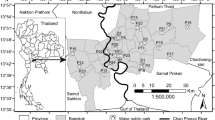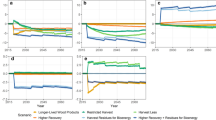Abstract
Purpose
This study seeks to answer the question, “Will the Million Trees LA (Million Trees Los Angeles, MTLA) program be a carbon dioxide (CO2) sink or source?” Because there has never been a full accounting of CO2 emissions, it is unclear if urban tree planting initiatives (TPIs) are likely to be effective means for reaching local reduction targets.
Methods
Using surveys, interviews, field sampling, and computer simulation of tree growth and survival over a 40-year time period, we developed the first process-based life cycle inventory of CO2 for a large TPI. CO2 emissions and reductions from storage and avoided emissions from energy savings were simulated for 91,786 trees planted from 2006 to 2010, of which only 30,813 (33.6 %) were estimated to survive.
Results and discussion
The MTLA program was estimated to release 17,048 and 66,360 t of fossil and biogenic CO2 over the 40-year period, respectively. The total amount emitted (83,408 t) was slightly more than the −77,942 t CO2 that trees were projected to store in their biomass. The MTLA program will be a CO2 sink if projected 40-year-avoided fossil fuel CO2 emissions from energy savings (−101,679 t) and biopower (−1,939 t) are realized. The largest sources of CO2 emissions were mulch decomposition (65.1 %), wood combustion (14.5 %), and irrigation water (9.7 %).
Conclusions
Although trees planted by the MTLA program are likely to be a net CO2 sink, there is ample opportunity to reduce emissions. Examples of these opportunities include selecting drought-tolerant trees and utilizing wood residue to generate electricity rather than producing mulch.



Similar content being viewed by others
References
Akbari H (2002) Shade trees reduce building energy use and CO2 emissions from power plants. Environ Pollut 116:119–126
Bratkovich SM (2001) Utilizing municipal trees: ideas from across the country. NA-TP-06-01. USDA Forest Service, Northeastern Area, State and Private Forestry, St. Paul, MN
Cairns MA, Brown S, Helmer EH, Baumgardner GA (1997) Root biomass allocation in the world’s upland forests. Oecologia 111:1–11
Chaparro L, Terradas J (2009) Ecological services of urban forest in Barcelona. Centre de Recerca Ecologica i, Aplicacions Forestals, Universitat Autonoma de Barcelona, Bellaterra, Spain
Climate Action Reserve (2010) Urban forest project protocol, version 1.1. Climate Action Reserve, Los Angeles
Costello LR, Jones KS (1994) WUCOLS project—water use classification of landscape species: a guide to the water needs of landscape plants. University of California, Cooperative Extension, ANR Publications, Oakland
Costello LR, Jones KS (2003) Reducing infrastructure damage by tree roots: a compendium of strategies. Western Chapter, International Society of Arboriculture, Cohasset
Drexhage M, Colin F (2001) Estimating root system biomass from breast‐height diameters. Forestry 74(5):491–497
Escobedo F, Varela S, Zhao M, Wagner JE, Zipperer W (2010) Analyzing the efficacy of subtropical urban forests in offsetting carbon emissions from cities. Environ Sci Pol 13(5):362–372
Fahey RT, Bialecki MB, Carter DR (2013) Tree growth and resilience to extreme drought across an urban land-use gradient. Arboricult Urban For 39(6):279–285
Gill SE, Handley JF, Ennos AR, Pauleit S (2007) Adapting cities for climate change: the role of the green infrastructure. Built Environ 33(1):115–133
Harmon ME, Silver WL, Fasth B, Chen HUA, Burke IC, Parton WJ, Hart SC, Currie WS, Lidet (2009) Long-term patterns of mass loss during the decomposition of leaf and fine root litter: an intersite comparison. Glob Chang Biol 15(5):1320–1338
Heisler GM (1986) Energy savings with trees. J Arboric 12(5):113–125
Jo HK (2002) Impacts of urban greenspace on offsetting carbon emissions for middle Korea. J Environ Manag 64(2):115–126
Kendall A, McPherson EG (2012) A life cycle greenhouse gas inventory of a tree production system. Int J Life Cycle Assess 17(4):444–452
Kovacs KF, Haight RG, Jung S, Locke DH, O’Neil-Dunne J (2013) The marginal cost of carbon abatement from planting street trees in New York City. Ecol Econ 95:1–10
Lefsky M, McHale M (2008) Volume estimates of trees with complex architecture from terrestrial laser scanning. J Appl Remote Sens 2(1):023519–023521
Leith H (1975) Modeling the primary productivity of the world. Ecol Stud 14:237–263
Marion W, Urban K (1995) User’s Manual for TMY2s—typical meteorological years. National Renewable Energy Laboratory, Golden
Markwardt LJ (1930) Comparative strength properties of woods grown in the United States. Tech. Bull. No. 158. U.S. Department of Agriculture Forest Service, Washington, DC
McCarthy HR, Pataki D (2010) Drivers of variability in water use of native and non-native urban trees in the greater Los Angeles area. Urban Ecosyst 13:393–414
McPherson EG (1998) Atmospheric carbon dioxide reduction by Sacramento’s urban forest. J Arboric 24(4):215–223
McPherson EG (2014) Monitoring Million Trees LA: tree performance during the early years and future benefits. Arboriculture & Urban Forestry
McPherson EG, Simpson JR (1999) Carbon dioxide reductions through urban forestry: guidelines for professional and volunteer tree planters. Gen. Tech. Rep. PSW-GTR-171. USDA Forest Service, Pacific Southwest Research Station, Albany
McPherson EG, Simpson JR, Xiao QF, Wu CX (2011) Million trees Los Angeles canopy cover and benefit assessment. Landsc Urban Plan 99(1):40–50
Melillo JM, Aber JD, Linkins AE, Ricca A, Fry B, Nadelhoffer KJ (1989) Carbon and nitrogen dynamics along the decay continuum: plant litter to soil organic matter. Plant Soil 115:189–198
Morani A, Nowak DJ, Hirabayashi S, Calfapietra C (2011) How to select the best tree locations to enhance air pollution removal in the MillionTreesNYC initiative. Environ Pollut 159:1040–1047
Nowak DJ (1994) Atmospheric carbon dioxide reduction by Chicago’s urban forest. In: McPherson EG, Nowak DJ, Rowntree RA (eds) Chicago’s urban forest ecosystem: results of the Chicago Urban Forest Climate Project. USDA Forest Service, Northeastern Forest Experiment Station, Radnor, pp 83–94
Nowak DJ, Stevens JC, Sisinni SM, Luley CJ (2002) Effects of urban tree management and species selection on atmospheric carbon dioxide. J Arboric 28(3):113–122
Nowak DJ, Greenfield EJ, Hoehn RE, Lapoint E (2013) Carbon storage and sequestration by trees in urban and community areas of the United States. Environ Pollut 178:229–236
Nzokou P, Simons J, Weatherspoon A (2011) Wood residue processing and utilization in southeastern Michigan, U.S. Arboricult Urban For 37(1):13–18
Pataki DE, Carreiro MM, Cherrier J, Grulke NE, Jennings V, Pincetl S, Pouyat RV, Whitlow TH, Zipperer WC (2011) Coupling biogeochemical cycles in urban environments: ecosystem services, green solutions, and misconceptions. Front Ecol Environ 9(1):27–36
Peper PJ, McPherson EG, Mori SM (2001) Predictive equations for dimensions and leaf area of coastal Southern California street trees. J Arboric 27(4):169–180
Pillsbury N, Reimer JL, Thompson R (1998) Tree volume equations for fifteen urban species in California. Tech. Rep. 7. Urban Forest Ecosystems Institute, California Polytechnic State University, San Luis Obispo, CA
Randrup TB, McPherson EG, Costello LR (2001) A review of tree root conflicts with sidewalks, curbs, and roads. Urban Ecosyst 5:209–225
Roman L, Scatena FN (2011) Stree tree survival rates: meta-analysis of previous studies and application to a field survey in Philadelphia, PA, USA. Urban For Urban Green 10:269–274
Roy S, Byrne J, Pickering C (2012) A systematic quantitative review of urban tree benefits, costs, and assessment methods across cities in different climatic zones. Urban For Urban Green 11(4):351–363
Scheu S, Schauermann J (1994) Decomposition of roots and twigs: effects of wood type (beech and ash), diameter, site of exposure and macrofauna exclusion. Plant Soil 163(1):13–24
Silver W, Miya R (2001) Global patterns in root decomposition: comparisons of climate and litter quality effects. Oecologia 129(3):407–419
Smith AC, Bhatti JS, Chen H, Harmon ME, Arp PA (2011) Modelling above- and below-ground mass loss and N dynamics in wooden dowels (LIDET) placed across North and Central America biomes at the decadal time scale. Ecol Model 222(14):2276–2290
Sola J, Niunez M, Gabarrell X, Boada M, Rieradevall J (2007) Service sector metabolism: accounting for energy impacts of the Montjuic Park in Barcelona. J Ind Ecol 11(2):83–98
Stone B (2012) The city and the coming climate: climate change in the places we live. Cambridge University Press, New York
Strohbach MW, Haase D (2012) Above-ground carbon storage by urban trees in Leipzig, Germany: analysis of patterns in a European city. Landsc Urban Plan 105(1–2):184–184
Strohbach MW, Arnold E, Haase D (2012) The carbon footprint of urban green space—a life cycle approach. Landsc Urban Plan 104(2):220–229
Summit J, McPherson EG (1998) Residential tree planting and care: a study of attitudes and behavior in Sacramento, CA. J Arboric 24(2):89–97
Tinus CA, LaMana M (2013) Converison efficiency and economics of urban wood utilization. Arboricult Urban For 39(1):25–30
US Environmental Protection Agency (2004) Median life, annual activity, and load factor values for nonroad engine emissions modeling. NR-005c. US Environmental Protection Agency, Washington DC
Yang J, McBride J, Zhou J, Sun Z (2005) The urban forest in Beijing and its role in air pollution reduction. Urban For Urban Green 3:65–78
Young RF (2011) Planting the living city: best practices in planning green infrastructure-results from major U.S. cities. J Am Plan Assoc 77(4):368–381
Acknowledgments
The authors are indebted to partners who assisted with this study. Los Angeles Conservation Corp’s Meghan Shearer led field data collection. MTLA’s staff were extremely supportive throughout the course of the study. George Gonzalez and Ron Lorenzen (LA Bureau of Street Services) as well as Laura Baurenfeind and Leon Boroditsky (LA Recreation and Parks Department) generously outlined their programs’ specific tree planting and stewardship activities. Ryan Allen (TreePeople) shared data on park tree planting and survival rates. Dr. James R. Simpson, Dr. Lara Roman, Paula Peper, and Shannon Albers (USDA Forest Service, PSW Research Station) provided technical support during portions of the study.
Author information
Authors and Affiliations
Corresponding author
Additional information
Responsible editor: Matthias Finkbeiner
Electronic supplementary material
Below is the link to the electronic supplementary material.
ESM 1
(DOCX 27 kb)
Rights and permissions
About this article
Cite this article
McPherson, E.G., Kendall, A. A life cycle carbon dioxide inventory of the Million Trees Los Angeles program. Int J Life Cycle Assess 19, 1653–1665 (2014). https://doi.org/10.1007/s11367-014-0772-8
Received:
Accepted:
Published:
Issue Date:
DOI: https://doi.org/10.1007/s11367-014-0772-8




